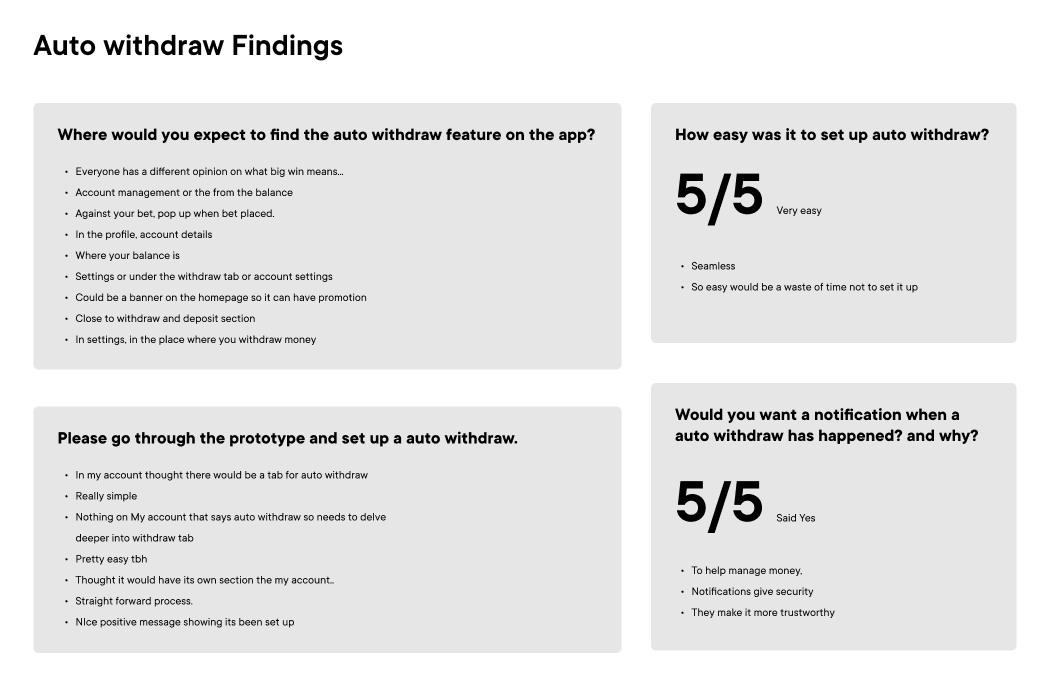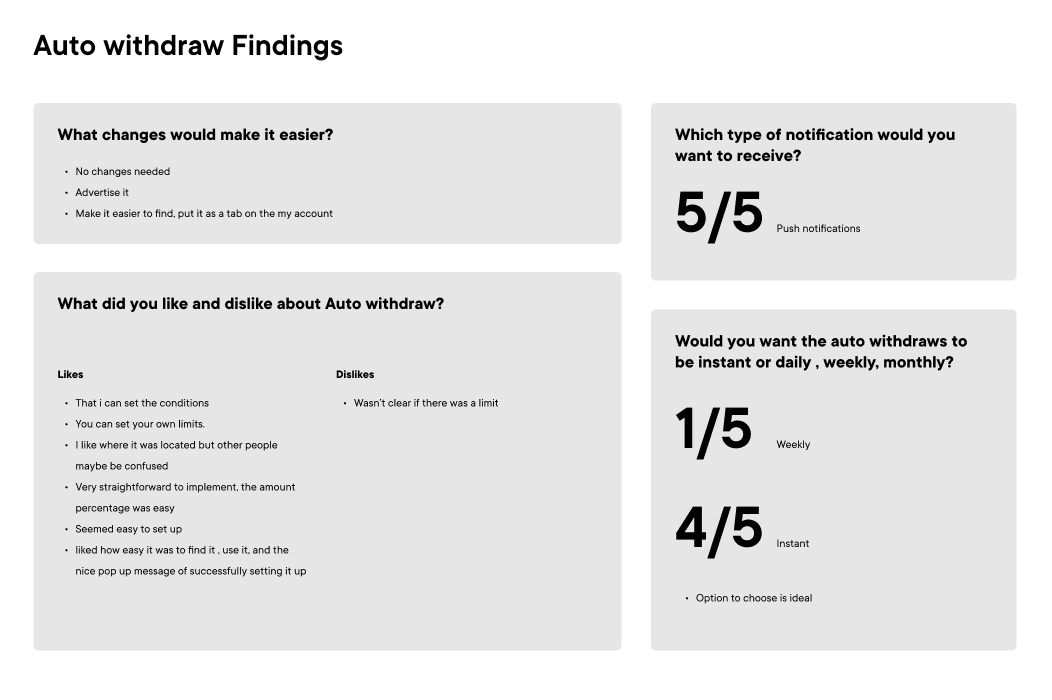Paddy Power
Case Study: Implementing the Auto Withdraw Safety Tool for Paddy Power
Introduction
Project Overview
Paddy Power, a leading online betting company, aimed to enhance its commitment to responsible gambling by developing an "Auto Withdraw" safety tool. This tool is designed to automatically withdraw funds from a user's account after reaching a specified threshold, promoting safer gambling practices and reducing the risk of financial harm.
Objective
To create a user-centric, compliant, and effective Auto Withdraw tool that supports responsible gambling while maintaining a seamless user experience.
Discovery Phase
Project Definition
The primary challenge was to address excessive gambling behaviors by providing users with a proactive mechanism to manage their funds. Success metrics included reduced instances of high-risk gambling, increased usage of responsible gambling features, and positive user feedback.
User Research
Methods: Conducted surveys and interviews with a diverse group of Paddy Power users to understand their betting habits and attitudes towards responsible gambling tools.
Key Findings: Users expressed a need for non-intrusive tools that provide financial control without disrupting their betting experience. Insights highlighted a preference for customizable thresholds and periodic reminders.
Competitive Analysis
Methods: Analyzed similar tools from competitors like Betfair and William Hill to identify best practices and potential gaps.
Findings: Many existing tools were either too intrusive or lacked customization options. This provided an opportunity to differentiate by focusing on user control and seamless integration.
Regulatory Review
Methods: Reviewed relevant gambling regulations and consulted with legal experts to ensure compliance.
Outcome: Developed a compliance checklist to guide the design and implementation phases, ensuring adherence to all legal requirements.
Ideation Phase
Brainstorming Sessions
Activities: Facilitated workshops with cross-functional teams including designers, developers, and stakeholders.
Outputs: Generated a wide range of ideas, including customisable withdrawal limits, periodic reminders, and integration with financial tracking tools.
User Personas
Creation: Developed detailed user personas based on research data, representing different segments of Paddy Power users, such as casual bettors, frequent gamblers, and high-risk users.
Example Persona: "Sarah, 35, frequent bettor, values financial control but dislikes interruptions during betting sessions."
User Journey Mapping
Process: Mapped out the user journey to identify critical touchpoints for intervention.
Outcome: Identified key moments for introducing the Auto Withdraw tool, such as during account setup, after significant wins or losses, and through regular activity reviews.
Prioritised Features
Customisable withdrawal thresholds
Periodic reminders and alerts
Integration with existing responsible gambling tools
Easy access to help and support resources
Design Phase
Wireframing
Tools: Created low-fidelity wireframes using Figma and Miro.
Outputs: Developed initial wireframes for key screens, focusing on user flow and functionality.
Prototyping
Tools: Used Figma to develop high-fidelity interactive prototypes.
Outputs: Created clickable prototypes for user testing, simulating the user experience and interactions.
Design System
Components: Added new items to the existing comprehensive design system including UI components, typography, and colour schemes.
Outcome: Ensured a consistent and cohesive design across all elements of the Auto Withdraw tool.
Testing Phase
Usability Testing
Methods: Conducted usability testing sessions with real users, using usertesting.com
Findings: Identified usability issues such as the complexity of setting limits and the intrusiveness of alerts.
Improvements: Simplified the process of setting limits and allowed users to customise alert frequency and type.
A/B Testing
Methods: Implemented A/B testing to compare different versions of the tool’s key features.
Results: Found that users preferred less frequent, more personalised alerts and a simple, clean interface for setting limits.
Decisions: Adopted the preferred design elements and interaction patterns for the final product.
Iterative Design
Process: Used iterative design sprints to refine the tool based on feedback.
Outcome: Developed updated prototypes and wireframes, incorporating insights from usability and A/B testing.
Development Phase
Collaboration with Developers
Methods: Maintained seamless communication between design and development teams through regular stand-ups and sprint planning meetings.
Tools: Used JIRA and Confluence for project management and documentation.
Outcome: Ensured that the development team had clear, development-ready design assets and documentation to guide implementation.
Agile Development
Approach: Followed agile methodologies for iterative development.
Process: Conducted sprint retros to continuously improve the development process.
Deliverables: Incremental releases of the Auto Withdraw tool, allowing for ongoing testing and feedback.
Quality Assurance
Methods: Performed thorough manual testing to ensure functionality and compliance.
Tools: Used JIRA and Slack for bug tracking and resolution.
Outcome: Ensured a high-quality, reliable product ready for launch.
Launch Phase
Market Strategy
Plan: Developed a comprehensive marketing plan to promote the Auto Withdraw tool.
Materials: Created communication materials including emails, Pop ups, and social banner content.
Launch: Launch campaign to reach all Paddy Power users.
Monitoring and Feedback
Methods: Monitored the tool post-launch to gather user feedback and track key metrics.
Tools: Used Google Analytics and Quantum Metrics for data analysis.
Outcome: Collected valuable insights for future iterations and improvements.
Post-Launch Phase
Data Analysis
Methods: Analysed user data to measure the impact and success of the tool.
Tools: Used descriptive and statistics, and data visualisation tools like Tableau and BI.
Findings: Positive trends in reduced high-risk gambling behaviours and increased user engagement with responsible gambling features.
Continuous Improvement
Process: Implemented a continuous improvement plan based on user feedback and data analysis.
Deliverables: Updated product roadmap and feature enhancement plan.
Outcome: Ongoing updates and enhancements to the Auto Withdraw tool, ensuring it remains effective and user-friendly.
Conclusion
Reflecting on the Project’s Impact
The implementation of the Auto Withdraw Safety Tool at Paddy Power has significantly transformed how users engage with the platform, emphasising responsible gambling and user safety. This innovative feature has not only set a new industry standard but also highlighted Paddy Power’s commitment to prioritising player well-being.
Lessons Learnt
Understanding User Needs: Deep user research and empathy mapping were critical in designing a tool that truly meets users' needs. Engaging directly with players through surveys and focus groups provided valuable insights into their concerns and preferences.
Importance of Iterative Design: The iterative design process allowed for continuous improvement and refinement of the tool. Regular usability testing and A/B testing were instrumental in identifying areas for enhancement, ensuring a user-friendly experience.
Balancing Functionality and Simplicity: Designing a tool that balances robust functionality with simplicity is crucial. Users appreciate intuitive interfaces that require minimal effort to understand and use effectively.
Communication is Key: Clear communication regarding the tool’s purpose and functionality is essential. Users must be educated on how to use the tool effectively and understand its benefits for it to have the intended impact.
Final Thoughts
The Auto Withdraw Safety Tool is a significant milestone in Paddy Power’s journey toward promoting responsible gambling. By prioritizing user safety and fostering a culture of responsibility, Paddy Power is not only enhancing its brand reputation but also contributing positively to the broader gambling industry. As the landscape evolves, continued innovation and user-centric design will be key to maintaining leadership and ensuring that gambling remains a safe and enjoyable activity for all users.








